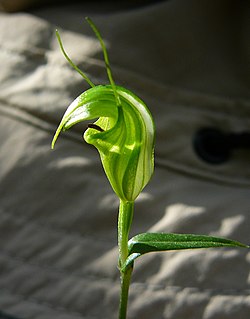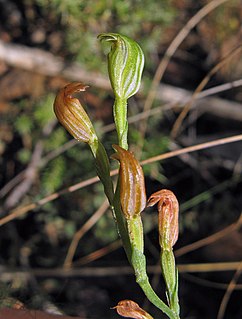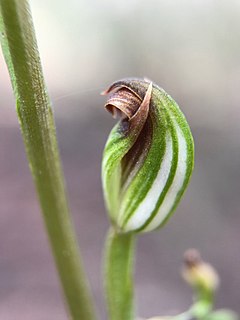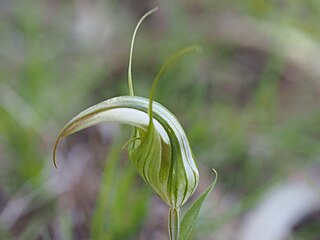
Pterostylis coccina, commonly known as the scarlet greenhood, is a species of orchid endemic to eastern Australia. As with similar greenhoods, the flowering plants differ from those which are not flowering. The non-flowering plants have a rosette of leaves flat on the ground but the flowering plants have a single flower with leaves on the flowering spike. In this species, the rosette leaves are relatively large and dark green, and the flowers are white, and bluish-green or red. It grows in New South Wales and north-eastern Victoria.

Pterostylis grandiflora, commonly known as the cobra greenhood or superb greenhood, is a species of orchid endemic to south-eastern Australia. As with similar orchids, the flowering plants differ from those which are not flowering. The non-flowering plants have a rosette of leaves but the flowering plants lack a rosette and have a single flower with leaves on the flowering spike. This greenhood has a green and white, striped flower with deep red-brown markings especially on its "galea", and a sharply pointed dorsal sepal.

Pterostylis baptistii, commonly known as the king greenhood, is a species of orchid endemic to eastern Australia. Flowering plants have a rosette of stalked, dark green leaves and a single white flower with green and brown markings, and a wide gap between the petals and lateral sepals. It occurs mostly in New South Wales but is also found in coastal Queensland and north-eastern Victoria.

Pterostylis alveata, commonly known as the coastal greenhood, is a species of orchid endemic to south-eastern Australia. As with similar greenhoods, the flowering plants differ from those which are not flowering. In this species, the non-flowering plants have a rosette of leaves flat on the ground but the flowering plants have a single small, shiny green and white flower with leaves on the flowering spike.

Pterostylis fischii, commonly known as Fisch's greenhood, is a species of orchid endemic to south-eastern Australia. As with similar greenhoods, the flowering plants differ from those which are not flowering. The non-flowering plants have a rosette of leaves flat on the ground but the flowering plants have a single flower with leaves on the flowering spike. This greenhood has tawny-coloured flowers, a dorsal sepal with a long thread-like tip and a labellum which is hidden inside the flower.

Pterostylis atrans, commonly known as the dark-tip greenhood or blunt-tongue greenhood, is a species of orchid endemic to south-eastern Australia. As with similar greenhoods, plants in flower differ from those that are not flowering. The non-flowering plants have a rosette of leaves flat on the ground, but the plants in flower have a single flower with leaves on the flowering spike. In this species, the flower is green and reddish brown with a protruding sinus and small club-like tips on the ends of the lateral sepals.

Pterostylis concinna, commonly known as the trim greenhood, is a species of orchid endemic to south-eastern Australia and which usually grows in colonies. It has a rosette of leaves at the base and a single dark green, white and orange-red flower.

Pterostylis decurva, commonly known as the summer greenhood, is a species of orchid endemic to south-eastern Australia. As with similar greenhoods, the flowering plants differ from those which are not flowering. The non-flowering plants have a rosette of leaves but the flowering plants have a single flower with leaves on the flowering spike. This greenhood usually flowers in summer and has a white flower with green stripes and a brownish tinge. It is similar to P. aestiva but has paler green flowers.

Pterostylis monticola, commonly known as the large mountain greenhood, is a species of orchid endemic to south-eastern Australia. It has a rosette of fleshy leaves at the base of the plant and a single dark green and white flower. It grows in alpine and sub-alpine colonies.

Pterostylis parviflora, commonly known as the tiny greenhood, is a species of orchid endemic to south-eastern Australia. As with similar orchids, the flowering plants differ from those which are not flowering. The non-flowering plants have a rosette of leaves but the flowering plants lack a rosette at the base but have up to eight tiny green, white and brown flowers.

Pterostylis revoluta, commonly known as the autumn greenhood, is a species of orchid endemic to south-eastern Australia. As with similar greenhoods, the flowering plants differ from those which are not flowering. The non-flowering plants have a rosette of leaves flat on the ground but the flowering plants have a single flower with leaves on the flowering spike. This greenhood has white and green flowers which have a long, curved, pointed labellum which extends beyond the sinus between the lateral sepals.

Pterostylis aneba is a species of orchid endemic to south-eastern Australia. It is a recently described and poorly-known greenhood similar to Pterostylis alpina and P. monticola. It has a rosette of fleshy leaves at the base of the plant and a single green and white flower. It grows in alpine and sub-alpine habitats.

Pterostylis striata, commonly known as the mainland striped greenhood, is a species of orchid endemic to south-eastern mainland Australia. As with similar orchids, the flowering plants differ from those which are not flowering. The non-flowering plants have a rosette of leaves but the flowering plants have a single flower with leaves on the flowering spike. This greenhood has a white flower with prominent dark green stripes and a brown-tipped dorsal sepal with a thread-like tip. Mainland striped greenhoods were formerly described as Pterostylis alata but that species is now recognised as a Tasmanian endemic.

Pterostylis rubescens, commonly known as the blushing tiny greenhood, is a species of orchid endemic to south-eastern Australia. As with similar orchids, the flowering plants differ from those which are not flowering. The non-flowering plants have a rosette of leaves but the flowering plants lack a rosette at the base and have up to eighteen tiny green, white and brownish flowers.

Pterostylis hildae, commonly known as the rainforest greenhood, is a species of orchid found in eastern Australia. It has a rosette of leaves and when flowering a rosette at the base of a flowering stem with a single green, white and brown flower. It is found in wet forests, including rainforest in New South Wales and Queensland.

Pterostylis longicurva, commonly known as the long-tongued greenhood, is a species of orchid endemic to eastern Australia. As with similar greenhoods, plants in flower differ from those that are not. Those not in flower have a rosette of leaves lying flat on the ground, but plants in flower have a single flower with leaves on the flowering stem. This species has a white and green flower with brown markings and a long, curved, brown labellum.

Pterostylis reflexa, commonly known as the dainty greenhood, is a species of orchid endemic to New South Wales. As with similar greenhoods, the flowering plants differ from those which are not flowering. The non-flowering plants have a rosette of leaves flat on the ground but the flowering plants have a single flower with leaves on the flowering stem. This greenhood has a relatively large white, green and light brown flower with a long, curved dorsal sepal and a protruding labellum.
Pterostylis russellii, commonly known as Russell's greenhood, is a species of orchid endemic to eastern Australia. Non-flowering plants have a rosette of leaves flat on the ground but flowering plants have a single shiny white and dark green flower on a flowering stem lacking a rosette but with a few spreading stem leaves.
Pterostylis subtilis, commonly known as the thin mountain greenhood, is a species of orchid endemic to New South Wales. It has a rosette of leaves and when flowering a single translucent white flower with dark green lines, a narrow, deeply notched sinus between the lateral sepals and a curved, protruding labellum.
Pterostylis uliginosa, commonly known as the marsh greenhood, is a species of orchid endemic to south-eastern Australia. As with similar orchids, the flowering plants differ from those which are not flowering. The non-flowering plants have a rosette of leaves but the flowering plants lack a rosette at the base but have up to three rosettes on lateral growths and up to seven small green and white flowers. This species only grows in wet places, usually where there is free water. There are usually only two or three flowers per plant, and only one or two are open at a time.





























